Montofoli: A World Apart
“Our hostess explains, laughing, that the name of this estate/vineyard in southern Evia probably means Mount of Leaves, from the Italian foglie, but that it could just as easily be Monto Folly or Mount of Fools. ‘It was madness to buy it and you have to be crazy to work as hard as we have to restore and maintain it,’ says Marianne Karacosta, originally of Sweden.”—Diana Farr Louis
Eating Well Is The Best Revenge
By Diana Farr Louis
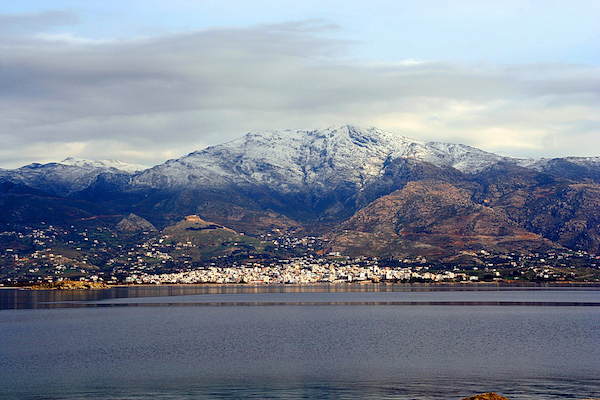
ANDROS Greece—(Weekly Hubris)—September 2018—Our hostess explains, laughing, that the name of this estate/vineyard in southern Evia probably means Mount of Leaves, from the Italian foglie, but that it could just as easily be Monto Folly or Mount of Fools. “It was madness to buy it and you have to be crazy to work as hard as we have to restore and maintain it,” says Marianne Karacosta, originally of Sweden.
But her husband, Pavlos’s, family came from Karystos, and a year before selling the family firm, Nounou, producer of evaporated and condensed milk, in 1987, he bought the estate, which had lain abandoned since the 1950s. One evening, he gathers us guests in a circle of marble blocks intended to remind us of Stonehenge, to tell us its story.
Karystos may not be as ancient as the Druids’ shrine, but it sent ships to reclaim Helen in the Trojan War, and Montofoli was once the site of Roman baths, a Venetian church, and the Turkish Pasha’s gardens. Roman finds from Montofoli, from almost illegible gravestones to well-weathered statues, account for most of the contents of the town’s two-room museum. But they litter the grounds as well, columns made of the famous green-streaked cipollino marble, so called because it’s layered like an onion (cipollo), amphorae and handles, column bases, and a staircase consisting of 157 marble steps that used to be part of the old road from the port up to the ‘suburbs’ and temples.
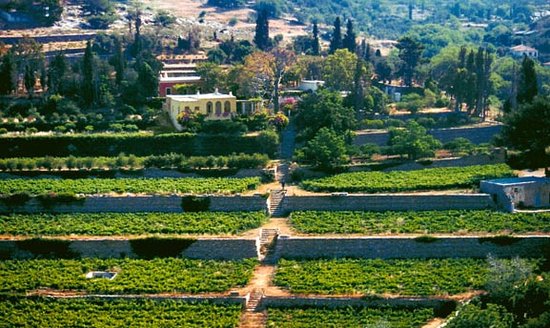
There were five buildings to restore, the oldest the much-ruined church of San Marco, with a bit of a stable which Pavlos has turned into the cellar where he stores his exquisite Montofoli dessert wines, made from sun-dried grapes, some aged as long as twelve years. A dovecote-now-residence sits on the ruins of the ancient baths: the main house with its three arches has both Venetian and Turkish sections, while the “red house” is 19th-century neoclassical.
Pavlos says, “They told me I was stupid to buy this, that because of the antiquities I’d never be able to do anything with it, but we proved ‘them’ wrong.”
We pore over an album of before and after photos, unable to grasp how the transformation came about, how from fallen beams, caved-in roofs and rubble-filled floors, all five buildings were restored so impeccably, modernized but faithful to the original structures. The main building, especially, reflects the couple’s taste and passion for the unusual: the ceiling in the living room is fashioned from several beautifully carved wooden doors obtained from an aristocratic mansion abandoned on Syros; the chandeliers are from Murano, both antiques and new; and wonderful family portraits of Pavlos’s formidable grandmother and other stern relatives decorate the wall above the handsome fireplace.
What fun it must have been to forage for these furnishings.
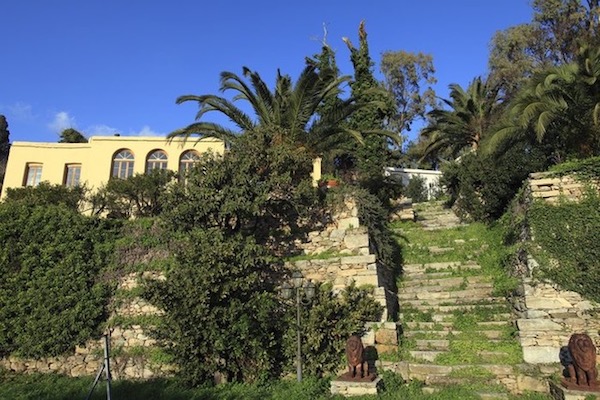
But we seem to have been gathered here mainly to eat. First, though, who are we? Our group of six women could not be more disparate. We include a dynamic travel agent from Vancouver with rainbow-colored hair; a holistic healer/documentary film maker from London, but with roots in Hyderabad, Pakistan, and Afghanistan; a Greek real estate agent/guide who grew up in Atlanta; a fashion blogger from Tel Aviv who was born in Kiev; and a tireless photographer from St. Petersburg, who also lives in Tel Aviv. These last two are my first ever “influencers,” with thousands of followers on Instagram and Facebook. And, lastly, there is me, posing as the local food expert.
We do have one thing in common with each other and our hosts: passion for what we do. Randi Winter’s agency is called Passionate Travel, Gulruck Khan’s has a spiritual component which imbues both her holistic healing practice and her documentary films. Roza Sinaysky wears her crisp intriguing outfits (something new several times a day) with delicate flair and Liya Geldman is never without her heavy camera or her laptop (working on an imminent exhibition in Tel Aviv). As for Alexandra Jelkes and I, we are passionate about Greece and its food.
It comes as a surprise to me that Karystos, which is well off the beaten tourist path, should have such a multitude of excellent restaurants. But our first meal—for Alexandra, my husband, and me—turns out to be a kind of high tea at 6 p.m., because we have spent the afternoon getting there and boat food is worse than unappealing. Marianne welcomes us in the roofed terrace area with home-cooked left-overs: the best bakaliaro skordalia (fried cod with garlic sauce) I think I’ve ever gobbled, spinach pie, and salad remnants. And yet, just a few hours later, we have plenty of room for the area’s best lamb chops, greens, and fries at O Dimitris, a rustic taverna in Aetos, in the hills above Montofoli.
The next day, a local chef comes to give us a lunchtime demo. Melios Hatzis has a taverna on the port, where we’ll dine the following evening, but the keftedes, greens in tomato sauce, and eggplant rolls he makes for us cannot be improved upon. Perhaps all of 40-something, cooking is something Melios has been passionate (that word, again) about since childhood, when he helped out at his family’s taverna, To Pithari, in Athens, which I remember, on the east side of Lycabettus Hill.
“I adored my grandfather and wanted to cook like him, so one day I grab a knife and start peeling potatoes over a bowl of water,” says Melios. “I’m only five and my pappou says, ‘Watch out, you’ll cut yourself.’ And, naturally, I do. The water turns red with my blood, but I don’t care. I’ve loved cooking ever since; it’s all I know how to do.”
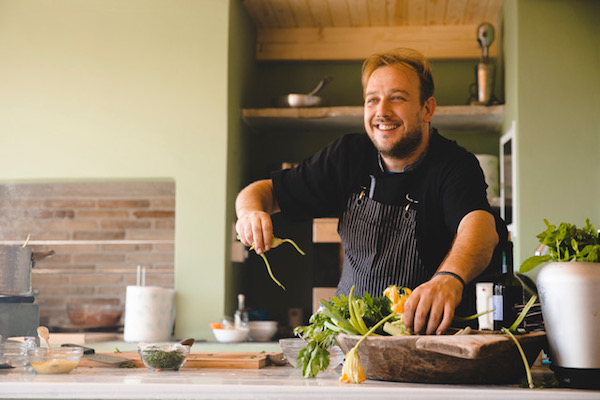
He’s worked in Athens and on Corfu but decided to open his own place in his wife’s home town. It’s long hours, especially in summer, so he doesn’t see his two kids much. “Ti na kanoume? What can one do? This is when we make the money that supports us year round.”
That evening, after Pavlos’s talk in the enchanted circle, our host takes us through the vineyard where liatiko (July) grapes are already red and ready to pick, and then into the former church/stable/cellar where a dozen or so barrels of sweet wine lie ageing. We have a degustation and then pile into three cars to go down to the port for another feast.
This time it’s Gevsiplous, a streamlined modern place, with a famous chef’s name attached (by Baxevanis). Pavlos orders for us all, luckily: otherwise, we’d still be there trying to decide what to order from the four-page menu, each dish sounding equally tempting. We end up with lentil salad with tarama mousse from herring eggs, fava with hazelnut vinaigrette, smoked eggplant purée (which our Israeli friends recognize as baba ghanoush), mushroom risotto, many more dishes that I can’t quite remember, and, the pièce de résistance: feta “doughnuts” (loukoumades) with a red pepper sorbet. Wow!
On our final day, Pavlos and Alexandra take us on a drive over the mountain down to a beach on the Cape Kafireas or Kavo Doro, the strait that separates Evia from Andros, notorious for the way it funnels winds.
Pavlos says the Venetians renamed it for the gold mines that may be located farther north. The road twists past remote hamlets and terraced olive groves, before we stop to ogle a waterfall, where a British family are enjoying showers. We would like to do the same, but push on to the coast at Potami, where lunch is waiting.
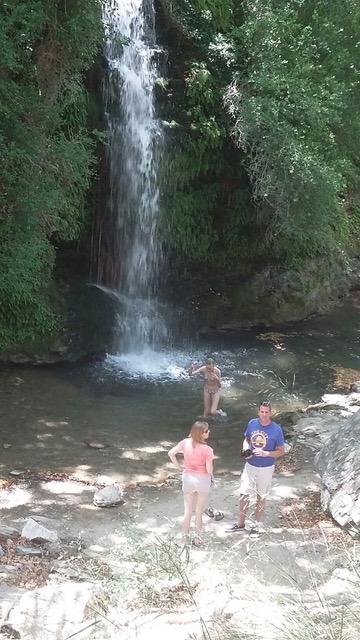
Potami, which means “river,” ranks high in my memory cupboard. Sometime in the 1970s, a friend and I had driven here with our two kids over the appalling coast road when we suddenly realized the sun had set and it was too late to turn back. Pushing on, hoping for a taverna, we spotted a couple of cases of empty beer bottles by the side of the road, indubitable signs of civilization. We turned in, crossed the dry river bed, and found a humble eatery with its kindly owners. They not only fed us—fried eggs, tomato salad, and fried potatoes—but they insisted we sleep in their beds: Greek hospitality, where the stranger is treated like a god, at its most genuine, spontaneous, seeking nothing in return.
I recognize the spot, amidst a smattering of new buildings, but alas we have to push on to our restaurant, a very smart stone complex on the cliff overlooking a long beach. Again. we eat like goddesses but we’re the only customers in this splendid spot. Gulruck suggests it would be ideal for a Yoga retreat.
Later that evening, as we’re basking in the Karacostases’ generosity while yet feasting again, at Melios’ charming taverna, Agoné, on the Karystos waterfront, I think how grateful I am to be part of this eclectic group; to have shared meals and stories with new friends from such different backgrounds. It’s possible that we will come together again, creating a package so that more people can enjoy the Montofoli experience, a rare treat filled with history, views, swims, delicious meals, and delicious wines, and spiked with passion.
![]()
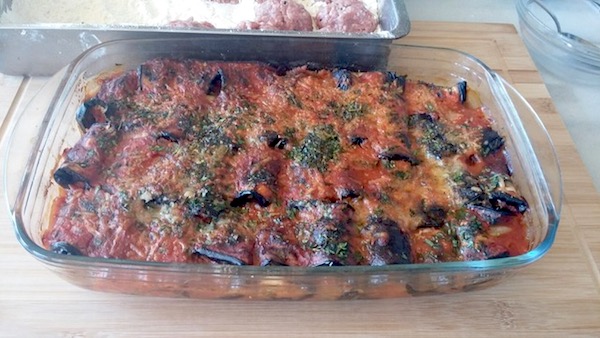
Recipe
Melios’s Eggplant Rolls with Feta Cheese
Here is Melios’s recipe for eggplant rolls with feta cheese. This is an easy dish, which Melios prepared for at least twelve people. It would be wonderful for a party since it’s best eaten at room temperature and looks very attractive. The measurements are approximate here—as I was not taking precise notes—but you can’t go wrong.
2 large eggplants, thinly sliced
Extra virgin olive oil for frying
Feta, ½ pound (if too much, eat later)
Garlic, lots, minced
Parsley, lots, minced
For the sauce:
A few spring onions and 1 medium dry onion, finely chopped
1 carrot, finely chopped
2-3 cloves garlic, minced
Extra virgin olive oil, a few tablespoons
8-10 ripe tomatoes, grated, skins discarded
Tomato juice, 1 cup
Salt and pepper
Pinch of sugar
2 cinnamon sticks
Dry white wine, ½ cup
Fry the eggplant slices in plenty of hot oil until lightly browned. Drain on paper towels. In a large saucepan, gently sauté the onions, carrot, and garlic together until the onions are soft and translucent. Pour in the tomato pulp and juice, seasonings, and wine, bring to a boil and cook over medium heat until you have a thick sauce.
When the eggplant slices are cool, sprinkle each one with the chopped garlic and parsley and wrap each slice around a piece of feta, about 1-2 inches thick and roll it up. Place all the eggplant cylinders in an oven-proof baking dish and pour the sauce over them. Bake at 375ºF/180ºC for about 30-40 minutes.
Allow 3-4 rolled eggplant slices per person. And serve with keftedes.
![]()
Karystos addresses:
Montofoli Wine Estate, Palaia Hora, 34001 Karystos, Evia 22240 23591, www.montofoli.gr, info@montofoli.gr. The estate is visitable on Saturday evenings in summer or by appointment.
O Dimitris Taverna, Ano Aetos, 22240 22604
Gevsiplous by Baxevani, Th. Kotsika 3, Karystos 22240 25697 (Executive Chef: Vaggelis Roudosis)
Agoné, Karystos waterfront (around the corner from Gevsiplous), 22240 31358 (also open some evenings in winter; Agoné means the heel of a loaf of bread, or the hearth).
![]()

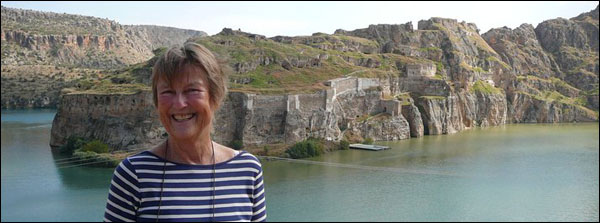
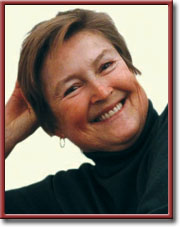
7 Comments
Pauline Panagiotou Schneider
You have made me right proper homesick and hungry.
Also, having bought a dilapidated, 57 acre property in Belize, and
restoring it and building new structures (albeit with far fewer resources than a Nounou heir might have), and being told I was crazy to do it, I can relate to the sweet taste of revenge when eating food I’ve grown, and plucking fruit from trees I have cared for.
Still, Belize is not Greece, and never will be.
Thanks for the recipe! Can’t wait to try it on my eggplants!
Balk William
What a wonderful sojourn! And a fabulous eggplant recipe to make! I cannot wait…
Diana
Pauline, thank you. How I would love to hear more of your story and what made you choose Belize over Greece. Kali orexi.
Maya Gingery
Thanks for the beautiful story, gustatory inspiration and photos. I am going to try your recipe soon! Maya
Anita Sullivan
Thank you for once again taking me off to heaven, Diana! I appreciate the warmth and vitality of your food-based tours of a country I love so much. Here in Oregon the summer harvest is winding down I just pruned my blackberry hedge last night, and this makes me feel a small connection to those wonderful people who work so hard to make the world stay beautiful!
Alexandra Jelkes
It was wonderful to read about your experience at Montofoli, during your visit for our special tour week, introducing The Phaidon Project to our Tour representatives and Influencers.
Montofoli is a private estate and vineyard built on ancient Hellenic ruins spanning two thousand years of Greek history that caters to the seasoned traveler, who is seeking a world-class experience which includes food, lodging, recreational and social activities. Our website offers more information for anyone interested in booking this tour, www. montofoliwines.gr, Phaidon Project. Thank you again.
Alexandra Jelkes, Tour Leader, Phaidon Project
Diana
Thanks, Maya, Anita (your description of blackberries makes me jealous because this year due to drought, we have no blackberries to poach next door), and Alexandra (it was so much fun to be with you on this adventures)